Nuts are generally considered pretty healthy food. They’re paleo, primal, and keto-friendly. Most nuts are packed with protein and low in carbs, making them an ideal afternoon snack.
What you probably don’t know is that nuts have some serious nutritional drawbacks too. They’re high in antinutrients and inflammatory fatty acids that can cause digestive issues, leaky gut syndrome, and chronic inflammation.
There’s a reason many nuts are in the yellow and red zones on the GoodGlow Diet Blueprint and not included in several of our Protocols in Unmasking Acne.
The truth is, eating certain nuts or too many nuts can cause acne for some people.
Not all nuts are created equal – This post is meant to be a guide to the pros and cons of various nuts, and what considerations you should take into account before you make them your go-to snack.
Article at a glance:
- The good: nuts contain acne-fighting nutrients vitamin E, selenium, and magnesium
- The bad: nuts contain high amounts of phytic acid, which can hurt your gut, and omega-6 fatty acids, which can cause chronic inflammation
- The safest nuts for acne: macadamia nuts, almonds, hazelnuts, and chestnuts
- The worst nuts for acne: pine nuts, walnuts, and peanuts
Acne-fighting foods mentioned in this article:
Why Some Nuts Cause Acne
Before we get too far in, we need to take a step back and ask an important question: why do some nuts cause people to break out?
In the eBook included in the Clear Skin Resource Kit, I summarize the problem with nuts as follows:
“Many nuts and seeds are likely to cause inflammation-driven acne due to a large amount of inflammation-causing omega-6 fatty acids. Furthermore, nut and seed intolerances are extremely common, and these can cause acne.”
It comes down to one simple thing: inflammation.
Inflammation is what makes a relatively harmless acne infection and turns it into a red, protruding, painful comedone (or pimple). Without excessive inflammation, acne infections are just routine bacterial infections that the body can take care of. With an overactive immune system or chronic inflammation, an acne infection is seen as a major threat, and the body overreacts by triggering a huge inflammatory response (you can read more about inflammatory acne here).
Nuts and seeds, in some people, are inflammation-causing foods for two primary reasons: omega-6 fatty acids and dietary intolerances.
You may have heard of omega-3 fatty acids or fish oil supplements that contain them? Well, omega-3 fatty acids are anti-inflammatory, they help prevent inflammation and thus inflammatory acne. On the other hand, omega-6 fatty acids are pro-inflammatory, meaning they cause inflammatory acne. Many nuts are loaded with omega-6 fatty acids, making them more likely than other foods to trigger acne.
Some nuts, like walnuts, seem to be high in omega-3 fatty acids, so no problem, right? Well, not quite. Plant-based foods contain ALA omega-3, which needs to be converted to DHA & EPA omega-3 before it can be used by the body – and guess what, only a fraction of the ALA makes it through. What you’re left with is a ton of inflammation-causing omega-6.
Furthermore, nut and seed intolerances are among the most common in the world. Certain people have an immune reaction to eating these nuts and seeds, which, you guessed it, triggers inflammation that can lead to acne.
The key thing to remember when it comes to safe nuts for acne-prone skin is this: less omega-3s and easy digestion is crucial.
Balancing Omega-3 and Omega-6 fatty acids properly are crucial for properly regulating sebum oil production and preventing chronic inflammation that can clog the pores. Additionally, because most nuts are so calorically dense a few handfuls can spike your insulin due to the high carbohydrate levels found in most nuts.
Dr. Anna Chacon
Safe Nuts for Acne-Prone Skin
Macadamia nuts
If you haven’t tried macadamia nuts you’re seriously missing out. Buttery, sweet, and extremely filling, macadamia nuts are the perfect snack for acne-prone individuals. Unlike other nuts, they have almost no omega-6 fatty acids and very little phytic acid. Macadamia nuts might not have all the protein and vitamins that other nuts have, but they more than makeup for it by being an extremely safe nut to eat. There’s very little chance that eating macadamia nuts will break you out.
Nutritional Overview (per ounce):
- 204 calories
- 1.5g net carbs (net carbs = total carbs – fiber)
- 2.2g protein
- Omega-6 (inflammatory) fatty acids: 0.37g
- Omega-3 (anti-inflammatory) fatty acids: 0.05g
- Omega Ratio: 6.5 : 1 (omega ratio not important here, very little total omega-6)
Pros:
- Much lower in omega-6 inflammatory fatty acids than other nuts
- Extremely low in phytic acid and other antinutrients
- No real reason to break you out other than an allergy
- Freaking delicious, seriously these things are amazing
Cons:
- On the more expensive side
- Easy to binge on: moderation is key
Good nuts for acne-prone skin
Almonds
It’s true almonds are a nutritional powerhouse. They’re one of the best sources of vitamin E on the planet, loaded with prebiotics, and high in magnesium. Vitamin E is absolutely crucial for clear skin, and almonds appear to be one of the best ways to get them. So what’s the problem? Almonds are also high in antinutrients and inflammatory fatty acids that cause acne. If you eat too many almonds it’s likely you’ll find yourself breaking out. With proper preparation, it’s also possible to minimize the antinutrients in almonds.
Nutrition Overview (per ounce):
- 163 calories
- 2.5g net carbs
- 6g protein
- Omega-6 (inflammatory) fatty acids: 3.4g
- Omega-3 (anti-inflammatory) fatty acids: Trace
- Omega Ratio: 2,000 : 1
- Phytic acid: 363mg
Pros:
- Almonds are loaded with Vitamin E. A single serving has upwards of 50% of the daily recommended value. A recent study found acne-prone individuals to be far more likely to be deficient in Vitamin E1https://www.ncbi.nlm.nih.gov/pubmed/23826827
- Almond skin has prebiotics that help promote a healthy gut microbiome and digestive system
- Almonds are high in protein, which promotes wound and skin healing
Cons:
- High in omega-6 inflammatory fatty acids that can trigger inflammatory acne
- High in phytic acid, an antinutrient that can cause digestive issues
Considerations:
- Always soak almonds for 10-12 hours if you can, it has been shown to considerably decrease the amount of phytic acid in them
- Portion control is crucial, just a handful is loaded with Vitamin E
- If you suffer from leaky gut syndrome, almonds likely aren’t a good nut choice due to their phytic acid content. While you’re fixing your digestive issues stick to nuts like macadamias
Hazelnuts
No, I’m sorry, this isn’t an excuse to pig-out on Nutella. Hazelnuts are a great source of skin-friendly nutrients including vitamin E, manganese, and magnesium. They’re low-carb and pretty high in protein too. They have less omega-6 than almonds and can be soaked to decrease phytic acid content. All and all, hazelnuts are a surprisingly powerful nut to add to your dietary arsenal.
Nutritional Overview (per ounce):
- 178 calories
- 2g net carbs
- 4.2g protein
- Omega-6 (inflammatory) fatty acids: 2.21g
- Omega-3 (anti-inflammatory) fatty acids: 0.02g
- Omega Ratio: 1,139 : 1
- Phytic acid: 459mg
Pros:
- High in vitamin E, manganese, and magnesium
- Relatively low amount of omega-6 fatty acids
- Hazelnut skin is loaded with polyphenols, an antioxidant-like compound also found in green tea2https://www.ncbi.nlm.nih.gov/pubmed/22955368. Polyphenols can prevent environmental factors like air pollution or smoking from harming your skin
Cons:
- High in phytic acid
Considerations:
- Always buy raw hazelnuts in the shell if you can
- Soaking hazelnuts in salt water for about 12 hours can help reduce the phytic acid content
Chestnuts
Unlike most of the other nuts here, chestnuts are low in protein and fat. Instead, they have plenty of carbs and very few nutrients. While they’re not likely to give you any major issues apart from potentially increasing blood sugar due to the carb content, they’re not going to give you any real health benefits either.
Nutritional Overview (per ounce):
- 105 calories
- 18.9g net carbs
- 1.2g protein
- Omega-6 (inflammatory) fatty acids: 0.21g
- Omega-3 (anti-inflammatory) fatty acids: 0.26g
- Omega Ratio: 0.83 : 1
- Phytic acid: 13mg
Pros:
- Low in both omega-6 inflammatory fatty acids and phytic acid
- One research study showed a diet containing high amounts of walnuts and cashews were high in antioxidants3https://www.ncbi.nlm.nih.gov/pubmed/17377830
Cons:
- Nutritionally empty, not a significant source of healthy fat or protein
- High in carbs, watch out if you’re trying to go low-carb/keto
Potentially problematic nuts for acne
Brazil Nuts
I first heard about these strange and expensive nuts while reading The Four Hour Body. Brazil nuts are an interesting food, they’re pretty massive in size, indigenous to South America, and highly coveted by many South American tribes. Nutritionally speaking they’re one of the only good sources of selenium on the planet, but they’re also extremely high in anti-nutrients. For this reason, balance is key when it comes to brazil nuts.
Nutritional Overview (per ounce):
- 186 calories
- 1.4g net carbs
- 4.1g protein
- Omega-6 (inflammatory) fatty acids: 5.81g
- Omega-3 (anti-inflammatory) fatty acids: 0.01g
- Omega Ratio: 487 : 1
- Phytic acid: 487mg
Pros:
- Incredibly high levels of selenium, which promotes a healthy immune system and improves antioxidant capacity (both crucial aspects for clear skin)
- High in magnesium
- Consistent consumption of brazil nuts have been shown to lower inflammation4http://www.ncbi.nlm.nih.gov/pubmed/24607303, which can improve inflammatory acne
Cons:
- Extremely high in phytic acid
- Very high in omega-6 fatty acids
Considerations:
- Two or three brazil nuts per day are plenty. The main health benefit of brazil nuts comes from their selenium content, which is so high that just a few per day is sufficient. Brazil nuts are also high in antinutrients, so eating too many can cause severe digestive issues.
Cashews
Cashews are a pretty boring nut to talk about, there’s not a whole lot that sticks out here. They have a decently high level of omega-6 fats, they’re higher in carbs (not keto-friendly), and a good amount of phytic acid. While there aren’t too many cons of cashews, there aren’t a lot of pros either.
Nutritional Overview (per ounce):
- 157 calories
- 7.6g net carbs
- 5.22g protein
- Omega-6 (inflammatory) fatty acids: 2.21g
- Omega-3 (anti-inflammatory) fatty acids: 0.02g
- Omega Ratio: 130 : 1
- Phytic acid: 527mg
Pros:
- Relatively low in omega-6 inflammatory fatty acids, less likely to cause inflammatory issues than nuts like almonds
Cons:
- Extremely high in phytic acid, an antinutrient that can disrupt the gut lining
- Relatively high in carbs, which can spike blood sugar and trigger the release of insulin, an acne-causing hormone (learn more about the link between carbs and acne here)
Considerations:
- Because of the extremely high phytic acid content, soaking cashews is a must if you’re going to be consuming them on a regular basis. Soak for 2-4 hours in saltwater.
- Always read the label, many cashews are coated in sugar or honey that can trigger breakouts due to the increased glycemic index.
- If you’re trying to avoid cashews entirely, always read the ingredients label of nut butter. Many almond butter varieties will contain cashews as well.
Pecans
My personal favorite-tasting nut on this list – pecans are not only delicious but also often overlooked for their health benefits. With very few carbs, a decent amount of protein, and only moderate levels of phytic acid, pecans aren’t all that bad for you after all. Where we run into issues is the omega-6 fat content. Just a handful of pecans can throw your whole omega-ratio out the window and lead to acne-causing inflammation. Moderation is key here.
Nutritional Overview (per ounce):
- 193 calories
- 1.2g net carbs
- 2.6g protein
- Omega-6 (inflammatory) fatty acids: 5.84g
- Omega-3 (anti-inflammatory) fatty acids: 0.28g
- Omega Ratio: 20.6 : 1
Pros:
- High in fiber, which can help promote a healthy digestive system
- Estimated to have about half the phytic acid content of almonds, making them a safe bet for your digestive system
Cons:
- Extremely high in omega-6 fatty acids (can cause inflammatory acne)
Considerations:
- A few pecans here and there aren’t likely to give you any issues. What you need to avoid is over-consumption of pecans due to the massive amount of omega-6 content, otherwise, you may trigger inflammation
Pistachios
Ahh, pistachios. Arguably the most frustrating nut to consume, pistachios also happen to be pretty freaking delicious. Not only do pistachios taste good, but they’re a good source of vitamin K, loaded with prebiotics, and relatively low in antinutrients too. All-and-all they’re not as nutritionally dense as almonds or as low in inflammatory fatty acids as macadamia nuts, but with moderate consumption, they shouldn’t cause any issues.
Nutritional Overview (per ounce):
- 160 calories
- 4.9g net carbs
- 5.7g protein
- Omega-6 (inflammatory) fatty acids: 3.74g
- Omega-3 (anti-inflammatory) fatty acids: 0.07g
- Omega Ratio: 52.8: 1
Pros:
- Pistachios are an even better source of prebiotics than almonds. They boost gut flora and lead to a healthy digestive system.
- Low in phytic acid
- One serving contains 17% of your recommended daily vitamin K
Cons:
- Relatively high in omega-6 fatty acids
- Relatively high in carbs, not exactly keto/low-carb friendly
Problematic nuts for acne
Pine nuts
I bet you’re just as surprised as I was to find out pine nuts are even a thing. Yep, and they’re fairly popular (and cheap) too. The problem with pine nuts boils down to the fact that they have an insane amount of omega-6 fatty acids per serving. Just a single ounce of pine nuts has nearly 10 grams of omega-6. You’d have to eat 4+ cans of sardines or 3+ salmon fillets just to balance out the omega-6’s from a single serving. So, is binging pine nuts worth it for acne-prone individuals? Probably not.
Nutritional Overview (per ounce):
- 178 calories
- 2.5g net carbs
- 3.3g protein
- Omega-6 (inflammatory) fatty acids: 9.52g
- Omega-3 (anti-inflammatory) fatty acids: 0.03
- Omega Ratio: 305 : 1
Pros:
- Low in carbs & high in magnesium
Cons:
- Extremely high in omega-6 fatty acids known to cause inflammation. Inflammation is one of the root causes of acne
Walnuts
You have to be careful with walnuts, their health benefits are weak compared to the massive amount of inflammation-causing omega-6 fats they carry. Just like pine nuts, this omega-6 content is enough to trigger inflammation that can exacerbate acne in most individuals. Even though walnuts contain a lot of omega-3’s, the sheer amount of omega-6’s in them cancels out any potential anti-inflammatory benefits. Many common trail and nut mixes have walnuts in them, so be careful and always remember to read the ingredients list.
Nutritional Overview (per ounce):
- 185 calories
- 2g net carbs
- 4.3g protein
- Omega-6 (inflammatory) fatty acids: 10.78g
- Omega-3 (anti-inflammatory) fatty acids: 2.56
- Omega Ratio: 4.2 : 1
- Phytic acid: 216mg
Pros:
- Moderately low in phytic acid
Cons:
- Extremely high in omega-6 fatty acids known to cause inflammation. Even though walnut’s omega ratio might look half-decent, the massive amount of omega-6 makes the omega-3 content much less valuable
Nuts to avoid for acne
Peanuts
Although peanuts aren’t technically considered a nut, they’re often consumed like one. Despite being delicious, peanuts are one of the single worst foods acne-prone individuals could eat. They’re so bad, I wrote an entire article on why you should avoid them. Not only are they loaded with phytic acid and lectins that can severely damage your digestive system, but they have an abysmal omega-fatty acid profile. Do yourself a favor and opt for healthier nuts like macadamias or almonds whenever you can. This is especially true for peanut butter, which often contains inflammation-triggering vegetable oils, stick to almond butter or even macadamia butter instead.
Nutritional Overview (per ounce):
- 166 calories
- 4g net carbs
- 7g protein
- Omega-6 (inflammatory) fatty acids: 4.54g
- Omega-3 (anti-inflammatory) fatty acids: Trace amounts
- Omega Ratio: 5,000 : 1
- Phytic acid: 270mg
Pros:
- On the surface, peanuts look healthy, low in carbs, high in fat and protein. In reality, just about every aspect of peanuts are a nutritious disaster
Cons:
- The high amounts of phytic acid and lectins in peanuts will likely cause digestive issues and possibly even leaky gut syndrome
- Peanuts carry the specific antinutrient (lectin) known as peanut agglutinin (PNA), which has been shown to disrupt the gut lining5https://www.ncbi.nlm.nih.gov/pmc/articles/PMC280694/
- Extremely high in omega-6 inflammatory fatty acids
- Allergies to peanuts are extremely common
- High in aflatoxin (a well-known carcinogen)
- Not a terrific source of any vitamins or minerals you can’t get in other, safer, healthier nuts
Conclusion
In case you didn’t want to skim through the article, here’s the list in its entirety:
- Safe: Macadamia nuts
- Good: Almonds, Hazelnuts
- Potentially Problematic: Brazil Nuts, Cashews, Chestnuts, Pecans, Pistachios
- Problematic: Pine Nuts, Walnuts
- Avoid: Peanuts
With the exception of peanuts, there isn’t really a nut you should look to entirely avoid. Each and every other nut on this list brings with it unique health benefits that you often can’t find in other foods. With that being said, moderation is everything when it comes to nuts.
Remember, our paleo ancestors weren’t huffing down 6 tablespoons of almond butter or 36 consecutive brazil nuts. We should treat nuts like a tool or a supplement for an overall healthier diet, not a staple.
If you’re looking for a comprehensive guide to clear skin from within, check out our new book, Unmasking Acne, which covers not only nuts, but also seeds, meat, seafood, vegetables, fruit, beverages, and more in detail. It’s everything you need to get clear skin from within.
Frequently Asked Questions
No, omega-6 fatty acids are pro-inflammatory. Eating a diet high in omega-6 fatty acids can cause inflammation all over the body which includes acne.
Pure almond butter does not cause acne. However, the majority of almond butters on the market contain cashews. Cashews are high in phytic acid, which is known to cause inflammation in the skin. If you are trying to optimize your diet to clear up acne make sure the almond butter you use does not contain cashews.
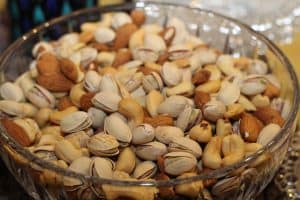
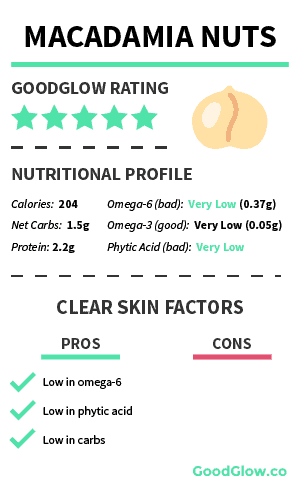
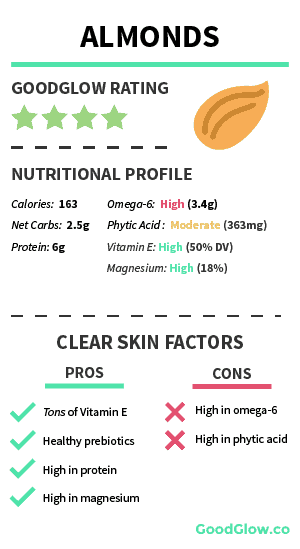
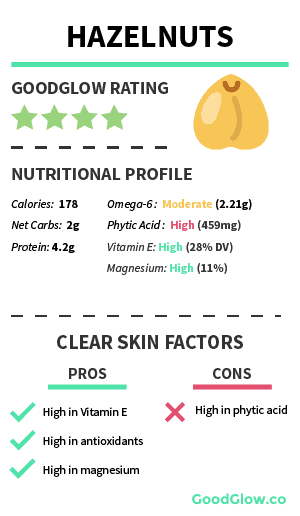
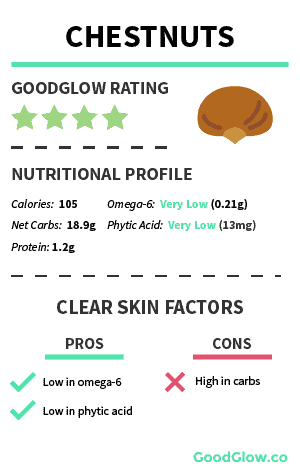
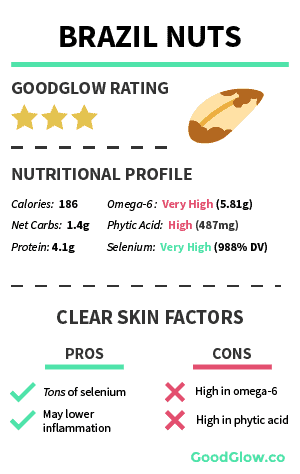
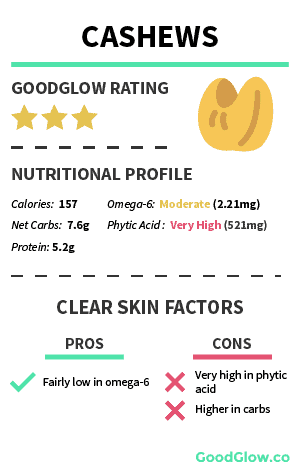
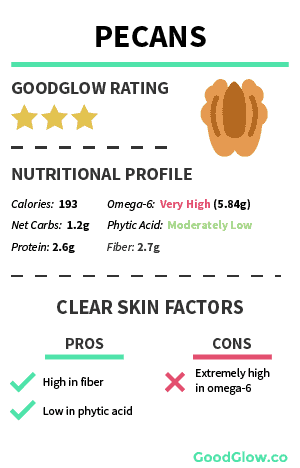
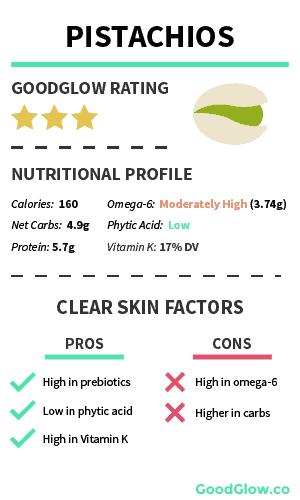
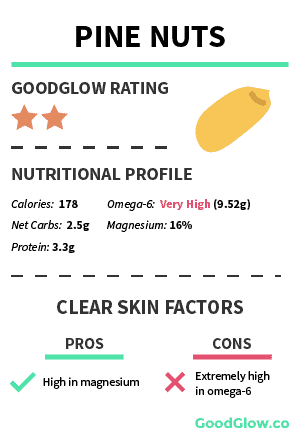
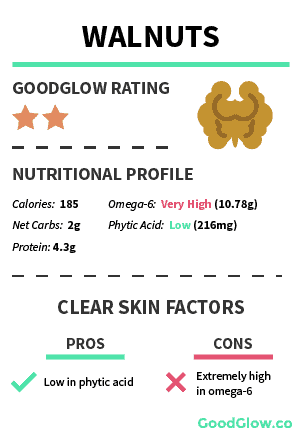
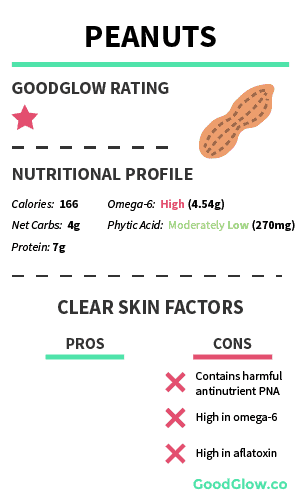
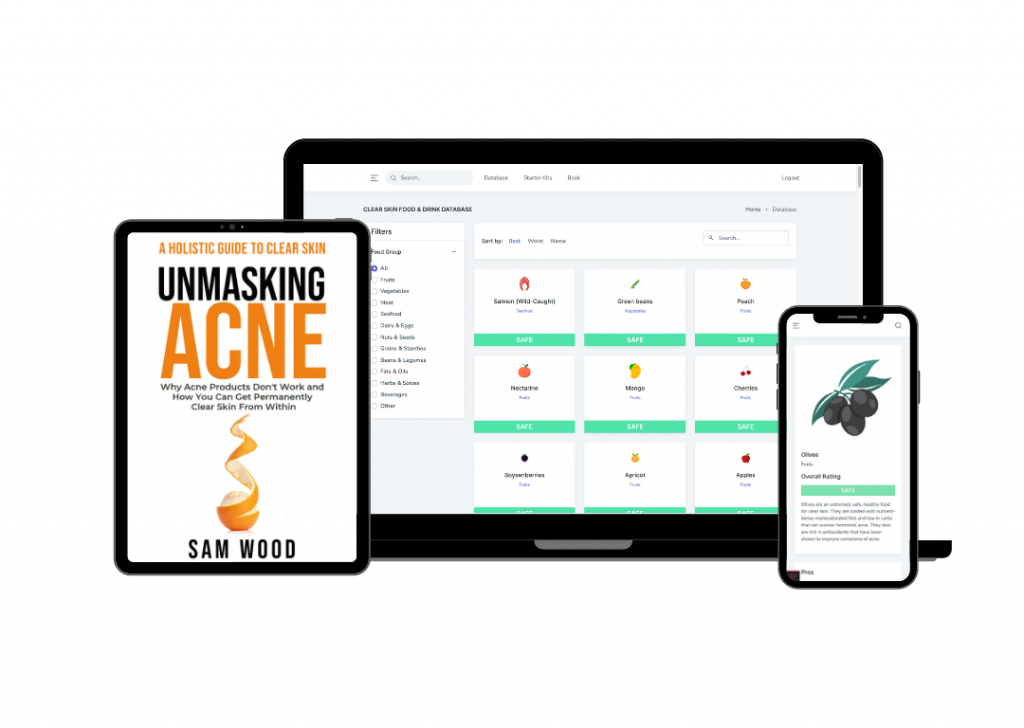
Hey, I don’t understand why walnuts are bad. Isn’t the omega 3:6 ratio what really counts and the absolute amounts of the fatty acids? The ratio in walnuts is an almost ideal 4.2:1 according to wikipedia, while for almonds it’s about 2000:1. So i don’t quite get this, wouldn’t the almonds and hazelnuts which are better rated pul the overall ratio of your diet into the wrong direction while walnuts would be sort of neutral in this regard?
Thank you so much for this blog btw!
I have the same doubt as Rok Drofenik.
Hi there!
What about wholenuts?
Walnuts omega 3 is ALA and ratio to Omega 6 just don’t add up. Considering that ALA is not as healthy a omega 3 like EPA and DHA.
Eating walnut and realized I still have acne. Would definitely avoid and stick to a few piece of coconuts.